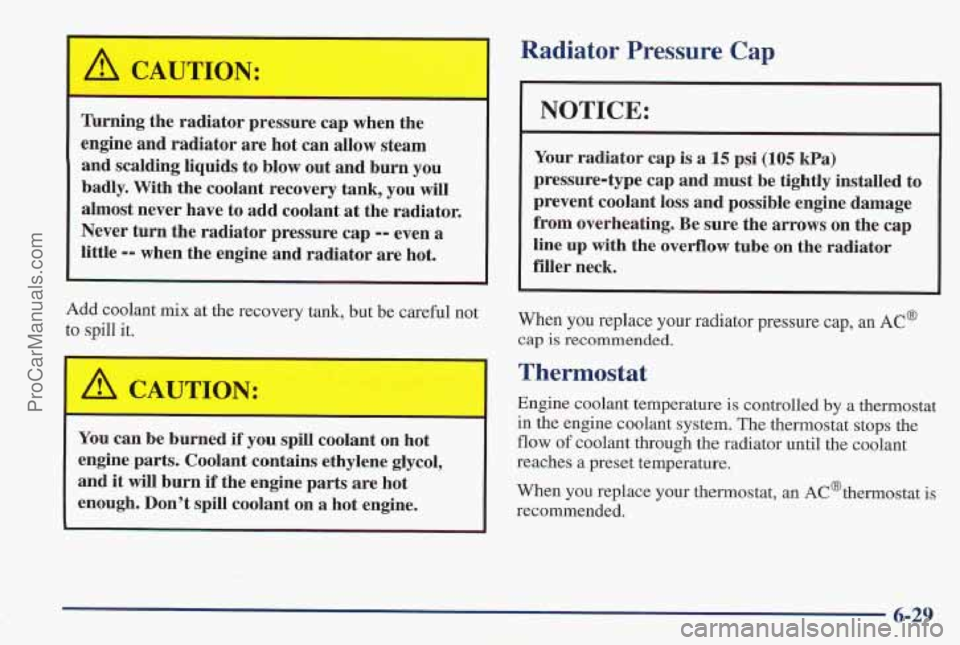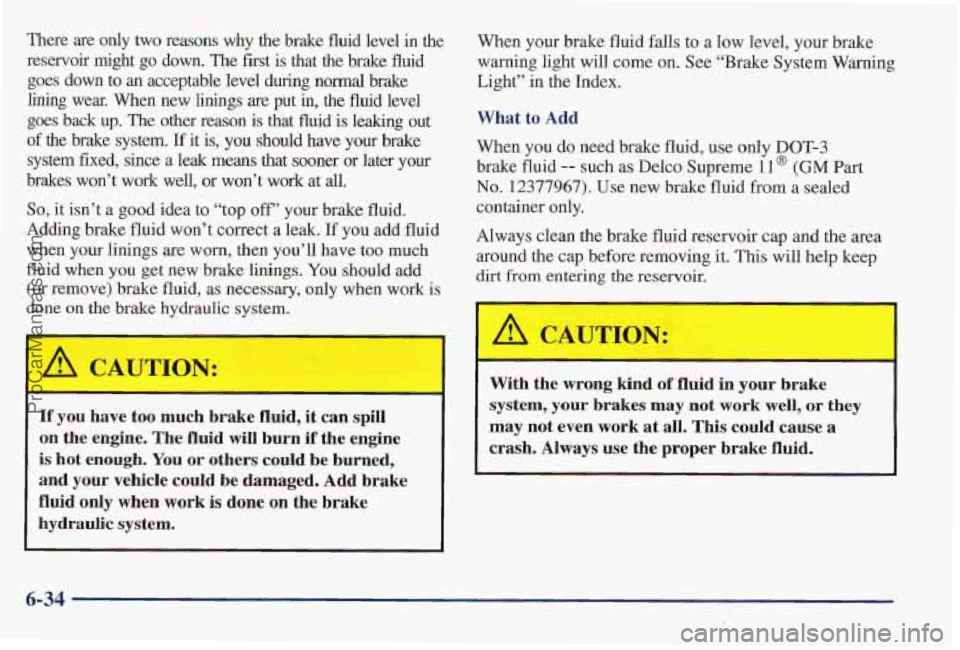Page 298 of 419
Checking Coolant
When your engine is cold, the coolant level should be
at the COLD mark or a little higher. To check coolant
level, remove the cap on the coolant recovery bottle and
verify that
the coolant level is up to the COLD fill level
on the hose attached to the cap.
LOW
COOLANT
If this light comes on, it
means
you’re low on
engine coolant.
Adding Coolant
If you need more coolant, add the proper DEX-COOL”
coolant mixture at the mulant recovery tank.
If the coolant recovery tank is completely empty, add
coolant
to the radiator. (See “Engine Overheating” in
the
Index.)
6-28
ProCarManuals.com
Page 299 of 419

Turning the radiator pressure cap when the
engine and radiator
are hot can allow steam
and scalding liquids to blow out and burn
you
badly. With the coolant recovery tank, you will
almost never have to add coolant at the radiator.
Never turn the radiator pressure cap
-- even a
little -- when the engine and radiator are hot.
Add coolant mix at the recovery tank, but be careful not
to spill it.
You can be burned if you spill coolant on hot
engine parts. Coolant contains ethylene glycol,
and it will burn
if the engine parts are hot
enough. Don't spill coolant on a hot engine.
I I
Radiator Pressure Cap
NOTICE:
Your radiator cap is a 15 psi (105 kPa)
pressure-type cap and must be tightly installed to
prevent coolant loss and possible engine damage
from overheating. Be sure the
arrows on the cap
line up with the overflow tube
on the radiator
filler neck.
When you replace your radiator pressure cap, an AC'
cap is recommended.
Thermostat
Engine coolant temperature is controlled by a thermostat
in
the engine coolant system. The thermostat stops the
flow of coolant through the radiator until the coolant
reaches a preset temperature.
When
you replace your thermostat, an AC@thermostat is
recommended.
6-29
ProCarManuals.com
Page 300 of 419
Power Steering Fluid
3100 Engine 3800 or 3800 Supercharged Engine
When to Check Power Steering Fluid
It is not necessary to regularly check power steering
fluid unless
you suspect there is a leak in the system or
you hear an unusual noise. A fluid loss in this system
could indicate
a problem. Have the system inspected
and repaired.
6-30
ProCarManuals.com
Page 301 of 419
How To Check Power Steering Fluid
When the engine compartment is cool, unscrew the cap
and wipe the dipstick with
a clean rag. Replace the cap
and completely tighten it. Then remove the cap again
and look at the fluid level on the dipstick.
3100 Engine
When the engine
compartment
is hot, the
level should be at the
H or
HOT mark. When it’s cold,
the le.vel should be at the
C or COLD mark. If the
fluid
is at the ADD mark,
you should add fluid. 3800 or 3800 Supercharged Engine
What to Use
Refer to the Maintenance Schedule to determine what
kind
of fluid to use. See “Recommended Fluids and
Lubricants” in the Index. Always use the proper fluid.
Failure to use the
proper fluid can cause leaks and
damage hoses and seals.
6-3 1
ProCarManuals.com
Page 304 of 419

There are only two reasons wny the brake fluid level in the
reservoir might go down. The first is that the brake fluid
goes down to an acceptable level during normal brake
lining wear. When new linings are put in, the fluid level
goes back
up. The other reason is that fluid is leaking out
of the brake system. If it is, you should have your brake
system fixed, since a leak means that sooner or later your
brakes won’t work well, or won’t work at all.
So, it isn’t a good idea to “top off’ y’our brake fluid.
Adding brake fluid won’t correct a leak. If you add fluid
when your linings are worn, then you’ll have
too much
fluid when
you get new brake linings. You should add
(or remove) brake fluid, as necessary, only when work
is
done on the brake hydraulic system.
If you have too much brake fluid, it can spill
on the engine. The fluid will burn
if the engine
is hot enough. You or others could be burned,
and your vehicle could be damaged. Add brake
fluid only when work
is done on the brake
hydraulic system. When your brake
fluid falls
to a low level, your brake
warning light will come on. See “Brake System Warning
Light” in the Index.
What
to Add
When you do need brake fluid,
use only DOT-3
brake fluid -- such as Delco Supreme 11 @ (GM Part
No. 12377967). Use new brake fluid from a sealed
container only.
Always clean the brake fluid reservoir cap and
the area
around the cap before removing
it, This will help keep
dirt from entering the reservoir.
With the wrong kind
of fluid in your brake
system, your
brakes may not work well, or they
may not even work at all. This could cause
a
crash. Always use the proper brake fluid.
6-34
ProCarManuals.com
Page 305 of 419

NOTICE:
Using the wrong fluid can badly damage
brake system parts.
For example, just a few
drops of mineral-based oil, such as engine
oil, in your brake system can damage brake
system parts
so badly that they’ll have to be
replaced. Don’t let someone put in the
wrong kind of fluid.
If you.spil1 brake fluid on your vehicle’s
painted surfaces, the paint finish can be
damaged. Be careful not to spill brake fluid
on your vehicle.
If you do, wash it off
immediately. See “Appearance Care” in
the Index.
Brake Wear
Your Pontiac has four-wheel disc brakes.
Disc brake pads have built-in wear indicators that make a
high-pitched warning sound when the brake pads are
worn and new pads are needed. The sound may come and
go
or be heard all the time your vehicle is moving (except
when
you are pushing on the brake pedal firmly).
The brake wear warning sound means that soon
your brakes won’t work well. That could lead
to
an accident. When you hear the brake wear
warning sound, have your vehicle serviced.
NOTICE:
Continuing to drive with worn-out brake pads
could result in costly brake repair.
6-35
ProCarManuals.com
Page 335 of 419
Vehicle Identification Number (VIN)
I
ENGINEA7 f ASSEMBLY
CODE MODEL YEAR PLANT
This is the legal identifier for your Pontiac. It appears on
a plate in the front corner
of the instrument panel, on the
driver’s side. You can see it if
you look through the
windshield
from outside your vehicle. The VIN also
appears on the Vehicle Certification and Service Parts
labels and the certificates of title and registration.
Engine Identification
The 8th character in your VIN is the engine code. This
code will help you identify your engine, specifications
and replacement parts.
Service Parts Identification Label
You’ll find this label on the underside of your trunk lid.
It’s very helpful if
you ever need to order parts. On this
label
is:
your VIN,
the model designation,
paint information and
0 a list of all production options and special equipment.
Be
sure that this label is not removed from the vehicle.
ProCarManuals.com
Page 339 of 419
Fuse
ECM
CRUISE
I/P-IGN SIR
TURN
ABS
BTSI
HVAC CTRL
DIC/HVAC
AB’S IGN
DRL
Description
ECM
Cruise Control ChimeMall Module, Cluster, Trip
Computer, Head-Up Display,
Brake-Transaxle Shift Interlock
Supplemental Inflatable Restraint
(Air
Bag)
Turn Signal
Anti-Lock Brakes
PRNDL, Brake-Transaxle Shift Interlock
Blower Control, HVAC
Rear Defog, HVAC, Driver
Information Center, Daytime
Running Lamps, Heated Seats
Anti-Lock Brakes Ignition
Daytime Running Lamps
Underhood Electrical Center
-- Passenger’s Side
Some fuses are in a fuse block on the passenger’s side of
the engine compartment. Pull off the cover labeled
FUSES to expose the fuses.
6-69
ProCarManuals.com